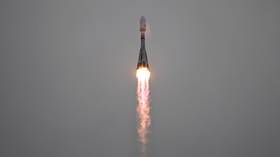Russian probe reaches lunar orbit ahead of historic landing attempt
All systems aboard the Luna-25 automatic interplanetary station are working normally, Russia’s space agency has reported
Russia’s space agency Roscosmos has reported that the Luna-25 automatic station has reached the satellite orbit of the Moon and is preparing to make a historic landing attempt on the lunar surface.
“All Luna-25 systems are functioning normally, communication with it is stable. Sessions are being taken to measure the current navigational parameters,” Roscosmos wrote in a statement published on Wednesday.
The agency noted that the mission marks the first time in Russia’s modern history that an automatic station has been sent to the moon. As part of this mission, Roscosmos said it intends to work on developing and testing soft landing technology, analyze the lunar soil, and conduct long-term scientific research, including on the upper layer of regolith of the Moon’s south pole, as well as the lunar exosphere.
It also noted that the Luna-25 expedition differs from its predecessors in that they all landed on the Moon’s equatorial zone, while this latest mission will attempt a soft landing in the polar region, which has a significantly more difficult terrain. The mission is expected to land on the Moon by August 21.
The Luna-25 mission was launched on Friday, August 11 aboard the Soyuz 2.1b rocket from the Vostochny Cosmodrome in Amur Region in Russia’s Far East. On Sunday, Roscosmos reported that the automatic probe had successfully switched on its research equipment and begun sending data back down to Earth, which is already being analyzed by the project’s scientific team.
Luna-25 is officially modern Russia’s first moon landing mission, but its name comes from a similar Soviet-era program that launched a total of 24 probes to the lunar surface between 1958 and 1976.
You can share this story on social media:








Comments are closed.